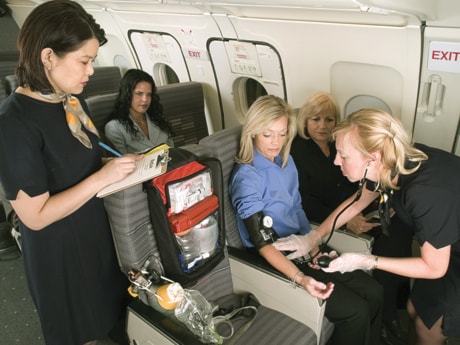TORONTO — If you’ve ever been on a plane, feeling a little dizzy or under the weather, the thought might cross your mind: How would the airline deal with a medical emergency in the air?
In fact, it’s a relatively common occurrence, and each airline has its own set of protocols.
WestJet has seen its number of incidents increase. There were 888 health-related issues in the air last year, including nine instances when planes were diverted for medical reasons, said Mark Frezell, director of in-flight for the airline.
“One, it’s due to the growth in our flights, and second, I believe it’s attributed to our aging population,” he said from Calgary.
Last month, a paper published in The Lancet looked at medical issues associated with commercial flights, and said that almost two billion people travel aboard commercial airlines every year.
Resources to deal with such situations include basic and advanced medical kits, automated external defibrillators and support from medical staff on the ground, said co-author Dr. Mark Gendreau of Lahey Clinic Medical Center in Burlington, Mass.
“To their credit, the airlines have really stepped up and enhanced their ability to deal with in-flight medical emergencies, over, I would say, the last eight years,” he said in an interview.
Typically, flight attendants or the captain will ask if there’s a doctor on board to assist, and will check credentials before accepting the help. A satellite phone or radio will be used to contact physicians on the ground.
WestJet and many other airlines around the world have contracts with MedAire, an Arizona-based company that took its first call at the MedLink Global Response Center in 1987.
It draws upon the expertise of physicians in the emergency department of Banner Good Samaritan Medical Center in Phoenix, and has access to more than 100 medical specialties.
MedLink receives about 17,000 calls a year from airplanes, said Heidi Giles MacFarlane, vice-president of strategic development. Altogether, there were 649 medical-related diversions in 2007, meaning that a plane had to land somewhere other than its planned destination so that a passenger could receive care.
But diversions are upsetting to passengers, require reprogramming of navigation equipment and can affect the landings and takeoffs of other flights, according to Gendreau.
“Airports charge the airline a fee for diverting the aircraft to their airport unexpectedly,” he said. “And this is not cheap. It can range from $5,000 to $25,000 depending on the airport.”
At Air Canada, spokesman Peter Fitzpatrick says the airline’s top priority is safety of all customers and crew.
“This is why it is very important that customers with medical conditions such as recent major surgery, or certain known illnesses or injuries, be approved for travel before the departure (48 hours),” he said in an email.
MacFarlane said the typical incidents on board are usually not that devastating.
“The most common injury — there are two, actually, that compete for top place. And one is appendage injuries from meal carts and beverage carts, so people get their knees hit frequently or their toes run over from the carts. And then objects falling from overhead storage bins.”
On the illness side, fainting is the most common event, she said.
For instance, someone might be winded from having run from a tight connection, or just be generally unwell.
In 2007, MedAire’s top medical complaint overall was neurological at 5,836 cases, followed by gastrointestinal at 3,373, respiratory at 1,699, cardiovascular at 1,393 and orthopedic at 733.
Recently, they received a call about a child who had ingested silica beads from a shoebox, and the parents were quite distraught, said MacFarlane.
“The MedLink physician was able to involve the poison control centre at the hospital to specifically discuss the chemical dangers of silica gel, which, by the way, happened to be benign — other than perchance making the child vomit.”
In terms of flight attendant training, Frezell said WestJet goes above and beyond Transport Canada standards that require a first-aid course once every three years.
“We try and teach them not only the skill and procedures around first aid but then how to manage the situation, and that’s a big part of it,” he said.
“Some specific things this year that we’re working on — we usually hit this every year — is CPR and using the automated external defibrillators, AEDs. They’re on every aircraft.”
A death on board is the worst experience, the experts agree. In 2007 there were 77 deaths on board flights that MedAire was assisting.
On the flip side, she said two babies were born on flights in recent months, and the mothers and babies were fine.
“It’s very, very frightening from a number of perspectives because you’re dealing with not just one life, but suddenly two. And there’s nothing more rewarding than being told that the baby’s been born and is crying — and it’s usually not just the baby that’s crying at that point.”
